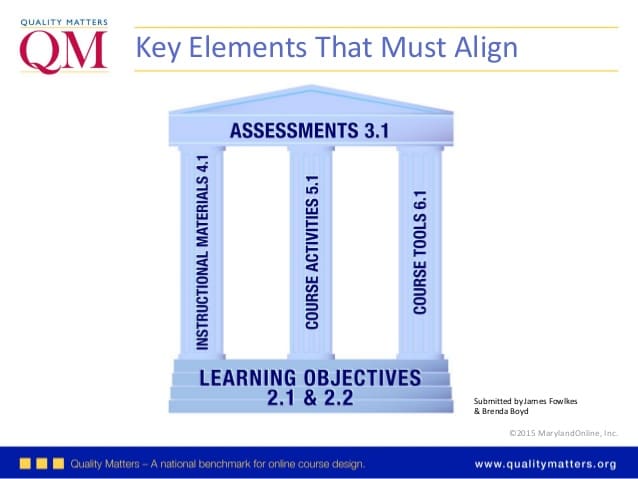Are you creating a new course or revising an old one? We recommend starting with these questions:
- What is the desired outcome?
- What should students be able to do by the end of the course?
What is Alignment?
Alignment refers to how course components work together to support achievement of the intended learning outcomes. Ensuring alignment can be a challenging exercise requiring careful reflection. As a best practice, start with the course learning objectives (CLOs) and work backward.
All of your
- Module Learning Objectives (MLOs)
- Assignments
- Discussions
- Quizzes/Exams
- Course materials
- Lectures
- Tools
should clearly and directly link back to and support the CLOs.
While course learning objectives (CLOs) set the expectations for the course as a whole, module (or unit) learning objectives (MLOs) directly support the CLOs but are specific to the individual unit. Assessments then serve to meet both module and course objectives, as do the tools and materials that students use to complete the assessments.
It’s important to be intentional when selecting course materials and tools and when creating learning activities. You may have a favorite article or tool you like to use, but is the purpose clear? Does each selection clearly and meaningfully link back to your course objectives?

Each learning activity should help students acquire the knowledge and skills necessary to meet the overall objectives. In turn, each task completed should also clearly reveal to you whether students have achieved the corresponding learning objectives.
The instructional materials and learning activities move progressively from simple to more complex and build on prior knowledge to prepare students to successfully meet the overall objective.
Imagine this scenario: One of your objectives is that students will summarize information or define key terms. The materials provided prepare students to meet this objective; however, the assignment requires them to evaluate and interpret information. In this situation, students are unprepared, likely unsuccessful, and most certainly frustrated. This demonstrates the importance of alignment.
In addition to reviewing these connections, consider the verbs used in your objectives and activities. While entry-level courses focus on establishing basic competence and understanding of concepts, students in advanced courses are ready to evaluate or create. Do your verb choices align with the intended level (and with each other)? Bloom’s taxonomy provides a framework for the increasing cognitive levels of engagement with learning tasks.
Why is alignment important?
- Alignment provides a map to your destination. It will guide your strategy as the course designer. It will also help you stay on track as you’re creating the course, giving you a baseline to measure against and ensuring all materials and activities support your overall goals.
- It decreases cognitive load for students. A clearly mapped course allows students to understand the purpose of each tool and activity and follow a well-lit path to the finish line. Where there’s meaning, there’s motivation!
A tool we find helpful is a Course Map. A course map is a visual representation of the ways in which your activities, materials, and objectives align. In addition to being a helpful resource for students, a course map is a great tool for ensuring alignment as you design. Course maps are now required in official (external) Quality Matters reviews. You’ll find a template and a sample course map in our Quality Matters at Clemson resource site. For a less linear approach, you might first consider a mind mapping tool to help you brainstorm and make connections.
Questions on alignment? Book a meeting with one of the Clemson Online staff to discuss.

Upcoming Events
Quick Hits – LockDown Browser
Thursday, August 31, 3:30-4:00 PM
Join this training to learn about new updates to LockDown Browser + Monitor and to have your questions about academic integrity software answered. Whether you have a specific question or want a Lockdown Browser topic demonstrated, this training opportunity is your time to work with one of our Lockdown Browser admins. When registering, choose whether to have a specific topic covered, enter your question, or both.
Facilitated by Gray Jackson, Learning Technology Specialist.
Modality: Virtual and synchronous—an Outlook Calendar invite, with the Zoom link, will be sent.
Registration: Quick Hits: LockDown Browser on August 31st .
Online Orientation and Course Presence
Wednesday, September 13, 1:30-2:15 PM
Encouraging your learners to engage with you, their peers, and your course starts with orienting them to online learning and establishing your presence. Join this presentation to learn more about deploying these principles in your course to encourage learner engagement.
Facilitated by Leslie Fuller, Ph.D., Digital Learning Strategist.
Modality: Virtual and synchronous—an Outlook Calendar invite, with the Zoom link, will be sent.
Registration: Online Orientation and Course Presence on September 13th
Clemson Online Fall 2023 Events Calendar

Review our Fall 2023 Events Calendar to see what Online Instruction Development opportunities await!
We have a robust Summer lineup of topics and live training formats to support your use of Canvas and other e-learning tools. Topics cover demonstrations of using Kaltura, presentations on inclusive practices for online education, and workshops to get your Canvas site ready to teach!
All of our live training is recorded. Registrants will automatically receive a link to that day’s video after it has been processed.
Contact James Butler with any questions regarding these sessions.

Clemson Online – Where Tech and Teaching Meet
